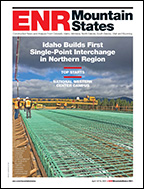The State Highway 114/121 corridor, also known as the Dallas-Fort Worth Connector, is undergoing a supersize upgrade. The $1-billion project expands and redesigns two interchanges and portions of four highways in addition to building 39 bridges and more than 100 retaining walls. The 8.4-mile-long route runs through the cities of Southlake, Grapevine and Irving as well as the northern edge of the Dallas-Fort Worth International Airport. The Texas Dept. of Transportation design-build project is being built by NorthGate Constructors LLC—a 65%-35% joint venture led by Kiewit Texas Construction LP with Zachry Construction Corp. The lead design engineer is PB Americas, a unit of Parsons Brinckerhoff.
The winning team beat out Gateway Connector Constructors—a joint venture of Fluor Enterprises Inc. and Balfour Beatty Infrastructure Inc.—with a 60,000 man-hour proposal that includes 70 additional perks valued at $200 million. Construction sequencing, for instance, reduces the amount of temporary travel lanes for an $18-million savings, while the earthwork plan eliminates 150,000 truckloads of construction material from merging with local traffic.
The fast-track project is currently scheduled to finish in mid-September, or about one year early. NorthGate will achieve this milestone, in part, through a detailed plan that anticipates 1,000 possible utility conflicts while mobilizing a round-the-clock labor force with more than 500 workers who will expend 3.5 million man-hours to complete the DFW Connector. There will be 2,400 activities during peak construction.
"If this had been built under the old system of building roads in Texas, and built in sections, it would have been 12 to 15 years before they were done," says Gary Fickes, Tarrant County commissioner, whose precinct includes Grapevine and Southlake. "If you're a contractor on a four-and-a-half year project, and you're building it in three-and-a-half years, you're saving a lot of money."
Big Vision, Big Job
The project will reduce commuter congestion across four of the region's most populous counties—Dallas, Collin, Tarrant and Denton—with a combined 6 million residents. About 189,000 motorists use the SH 114/121 corridor daily. However, traffic volume is anticipated to reach 359,000 daily motorists by 2030.
"This region adds about 1 million people every seven to 10 years," says Tony Hartzel, spokesman for the Texas Dept. of Transportation (TxDOT). "This project doubles the current capacity, in certain areas, with managed lanes and an eye toward the future."
DFW Connector improvements have been in the making for more than a decade due to funding demands. The project pieces together funds from a combination of sources, including $667 million in state gas tax revenue, $260 million in federal stimulus money and $139 million in voter-approved state revenue bonds. The DFW Connector is receiving the most American Recovery and Reinvestment Act funding of any transportation project nationwide. Remaining portions of the total 14.4-mile project are still unfunded.
This ambitious investment will move 3.6 million cu yd of dirt—enough to fill 41 Olympic-size swimming pools—erect 2,000 steel bridge girders and place 152 lane miles of pavement. NorthGate Constructors, which has 100 subcontractors and suppliers, was awarded the contract in March 2009. The design was roughly 60% complete when the joint venture broke ground 11 months later.
A project of this magnitude requires careful planning and coordination. "Our project isn't broken into segments. We're working on all components simultaneously," says Alyssa Tenorio, a NorthGate Constructors representative. "We have 10 different teams organized by discipline, each with its own project management staff. Everyone meets once a day, five times a week inside the 'war room' to discuss work needs, organization of tasks and scheduling as well as other critical issues."





Post a comment to this article
Report Abusive Comment